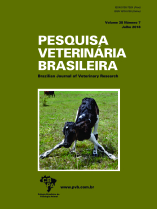 |
|
|
|
Year 2018 - Volume 38, Number 7
|

|
Comparison of three diagnostic methods for Salmonella enterica serovars detection in chicken rinse, 38(7):1300-1306
|
ABSTRACT.- Corrêa I.M.O., Pereira L.Q., Silva I.G.O, Altarugio R., Smaniotto B.D., Silva T.M., Okamoto A.S. & Andreatti Filho R.L. 2018. Comparison of three diagnostic methods for Salmonella enterica serovars detection in chicken rinse. [Comparação de três métodos diagnósticos para detecção de Salmonella enterica em lavados de carcaça de frango.] Pesquisa Veterinária Brasileira 38(7):1300-1306. Laboratório de Patologia Aviária, Departamento de Clínica Veterinária, Faculdade de Medicina Veterinária e Zootecnia, Universidade Estadual Paulista, Botucatu, São Paulo, SP 18618-970, Brazil. E-mail: isamainieri@yahoo.com.br
Salmonella detection is a key point in food safety testing, because of the frequent association of this pathogen with food poisoning in humans. The standard bacteriological tests currently used for Salmonella-detection are time-consuming; therefore, there is a need to develop alternative methods to accelerate the detection. In order to accelerate Salmonella diagnosis, we used the immunomagnetic separation assay associated with bacteriophage P22 for the rapid detection of the following Salmonella serovars in chicken rinses of drumsticks, artificially contaminated with 5, 10, and 100 CFU/25mL of bacteria: Salmonella enterica subsp. enterica serovar Heidelberg (S. Heidelberg), Salmonella enterica subsp. enterica serovar Enteritidis (S. Enteritidis) and Salmonella enterica subsp. enterica serovar Typhimurium (S. Typhimurium). The efficiency of the technique, represented by the time required for detection of positive and negative samples, was compared with that of the standard diagnostic tests used for this pathogen, the bacteriological assay and the polymerase chain reaction (PCR)-based test. This study confirmed the ability of the bacteriophage-associated immunomagnetic separation assay to identify 99.6% of Salmonella-positive samples of the three serovars tested. In contrast, the bacteriological assay and PCR-based test detected 95.1% and 98.5% of the Salmonella-positive samples respectively.
|
| |
|
|
| |
|
 |